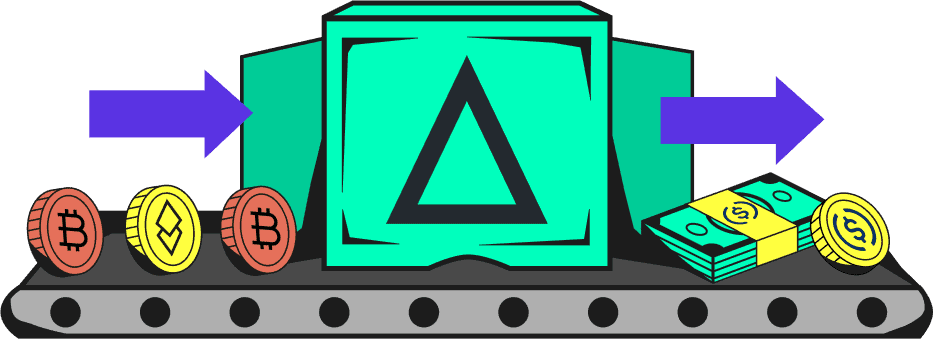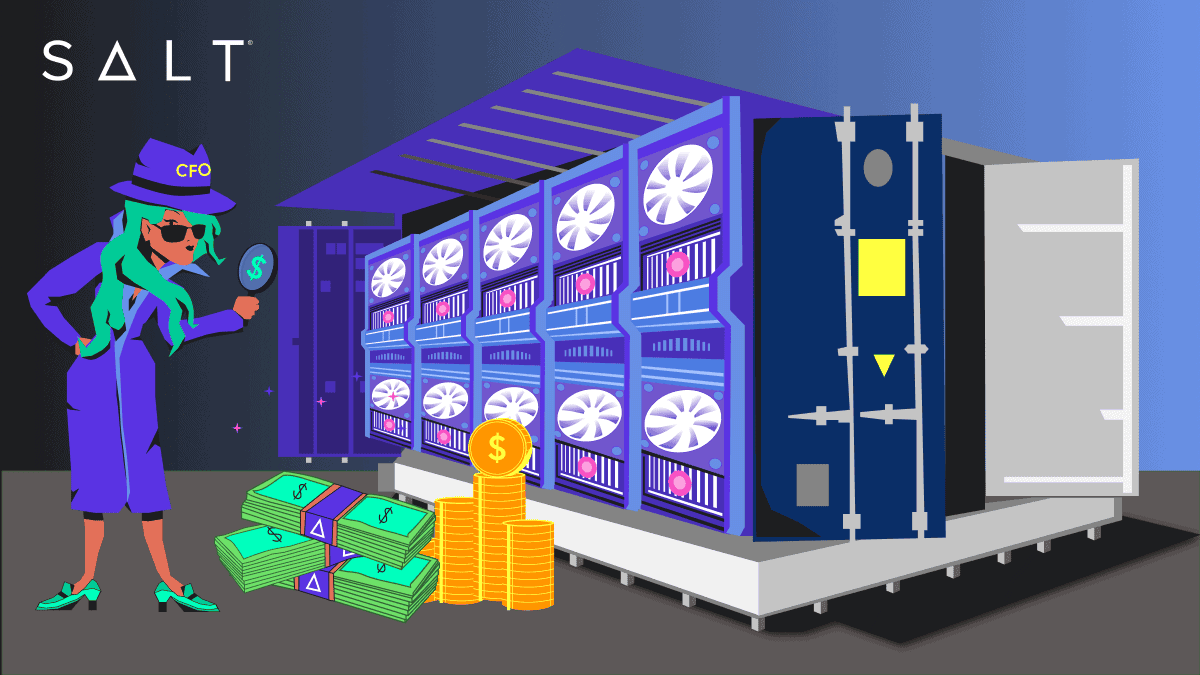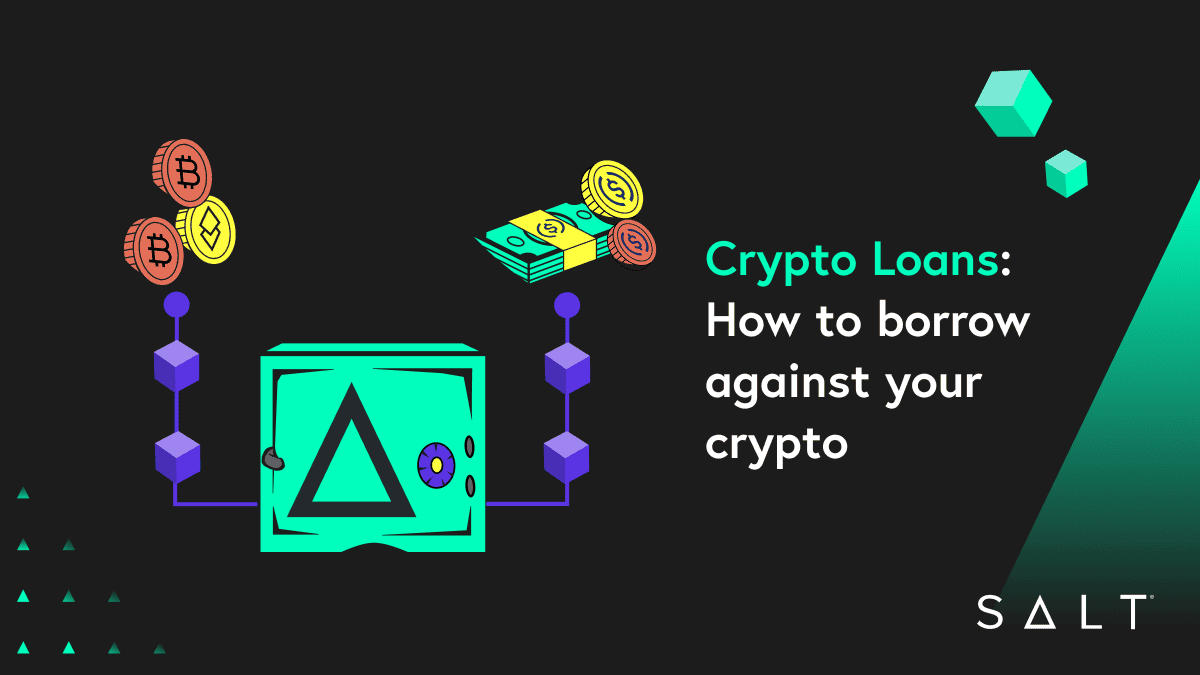Are you considering investing in a Bitcoin mining container to tap into the exciting world of cryptocurrency mining?
If so, we’re here to talk to you about what you need to know before you start searching for the best setup. Bitcoin mining containers are a game-changer in the industry, and their potential benefits are hard to ignore. Bitcoin mining is a lucrative venture, but it requires significant upfront capital, especially when considering the acquisition of Bitcoin mining containers.
But as you contemplate this investment, here’s a valuable tip: SALT Lending can help you get the equipment you need while lowering the barriers to entry. Now, let’s dive into how Bitcoin mining containers work and what sets them apart from traditional mining setups.
Bitcoin Mining Containers: A Technological Marvel
To understand Bitcoin mining containers, it’s essential to grasp their inner workings. These containers house all the vital components needed to operate ASIC machines, also known as Bitcoin miners. These components include shelving, electrical and network infrastructure, and advanced cooling and filtration systems. What truly sets them apart from traditional mining setups is their mobility and self-contained nature, making them a plug-and-play solution for mining operations.
What are Bitcoin Mining Containers?
A bitcoin mining container, represents a self-contained module tailored for the accommodation and operation of cryptocurrency mining rigs. These modular solutions come in diverse dimensions and layouts, tailored to suit the specific requirements of the mining endeavor. Typically constructed from robust materials, these containers boast advanced cooling, ventilation, and power distribution systems, all meticulously designed to guarantee peak performance and maximize energy efficiency.
What components usually make up a crypto mining container?
A crypto mining container typically comprises the following essential elements:
Mining Hardware: These are the physical devices used for cryptocurrency mining, such as ASIC (Application-Specific Integrated Circuit) or GPU (Graphics Processing Unit) rigs. They perform the actual mining process and generate cryptocurrencies.
Temperature Control and Ventilation Systems: These systems are designed to manage the temperature within the container and prevent the mining hardware from overheating. They often consist of air conditioning units, fans, and ventilation ducts, ensuring an optimal operating environment for the mining rigs.
Power Distribution Infrastructure: Responsible for distributing electricity to the mining rigs and other container components, power distribution systems may incorporate transformers, switchboards, and distribution panels. Their role is to maintain a stable and reliable power supply for the mining operation.
Monitoring and Control Systems: These systems offer real-time oversight and management of the mining activities. They may consist of sensors, meters, and software solutions that enable miners to track their rig’s performance, regulate power consumption, and optimize mining operations for peak efficiency.
Security Measures: To safeguard the mining operation against unauthorized access, theft, and other security risks, security systems are essential. These measures can include surveillance cameras, access control systems, and alarms, ensuring the safety of both the mining container and the valuable mining hardware it houses.
Key Benefits of Bitcoin Mining Containers
Density and Environmental Impact: Bitcoin mining containers allow for the execution of the same amount of net hashpower with minimal land use and a reduced carbon footprint. This density is a game-changer in the mining industry.
Mobility: Unlike traditional mining setups with fixed electrical and network infrastructure, mining containers are mobile. This mobility enables relocation to remote locations, such as areas with stranded gas resources, offering newfound flexibility. Additionally, they feature remote management capabilities, making them easier to operate.
Controlled Environment: These containers maintain a controlled environment crucial for mining efficiency. They provide the cooling and filtration required to keep temperatures low and prevent dust and debris buildup. Importantly, they can be kept separate from other business operations, ensuring uninterrupted mining.
Higher Degree of Certainty: Since these containers are pre-manufactured, they offer a higher degree of certainty in deployment. With a significant portion of the infrastructure being plug-and-play, successful deployment becomes more predictable compared to traditional setups.
Pre-Manufactured Electrical: One of the most critical aspects of Bitcoin mining is electrical infrastructure. Traditional in-building setups often require extensive knowledge, time, labor, and permitting, which can easily derail budgets. In contrast, Bitcoin mining containers come with pre-manufactured electrical systems, simplifying setup and reducing cost.
Drawbacks of Bitcoin Mining Containers
Investing in Bitcoin mining containers is an ambitious endeavor, and the initial cost can be substantial. These costs include not only the containers themselves but also the mining rigs, cooling systems, power infrastructure, and other components necessary for a successful mining operation. For many miners, finding the cash to cover these expenses can be a significant challenge. Thus, while Bitcoin mining containers offer numerous advantages, the main drawback is the upfront expense. However, in most cases, this upfront cost can translate into lower overall expenses over time.
This is where a well-thought-out treasury management strategy comes into play. By leveraging your existing crypto assets and optimizing your financial resources, you can secure the funds needed to acquire Bitcoin mining containers.
[Did you know SALT Lending lets you borrow against your bitcoin to access liquidity? Don’t sell your Bitcoin. Borrow against it, here.]
Energy Efficiency and Sustainability
Bitcoin mining containers significantly impact the energy efficiency of mining operations. Their controlled environments allow for precise temperature control, and the cooling methodologies employed, whether air, immersion, or hydro-based, are evolving. These advanced cooling methods maximize hash power and reduce wattage consumption, contributing to reduced electricity consumption and increased computational hash power, especially at scale.
Real-World Success Stories Using Bitcoin Mining Containers
Several real-world examples illustrate the effectiveness of Bitcoin mining containers:
- Power generation sites utilize excess or unused energy, such as solar and wind, for mining. They also tap into stranded or flare gas resources that would otherwise go uncaptured.
- Large manufacturing companies leverage their electrical infrastructure during off-hours for mining, optimizing their resources.
- Real estate investors and joint venture companies have found immense benefits in using mining with ASICs and containers. This approach generates revenue, builds digital assets, and bolsters balance sheets for hedging purposes.
SALT Lending: Liquidity Potential
SALT Lending plays a crucial role in this context by lowering the barrier to entry. By offsetting upfront costs, SALT frees up capital for the overall project or goal. This enables clients to realize revenue and profits much sooner and facilitates rapid scalability, all without the need to sell their Bitcoin holdings. Holding onto Bitcoin long-term while developing infrastructure and deploying more revenue-producing assets further boosts Bitcoin creation.

Treasury Management and Mitigating Risks
In the world of cryptocurrency, treasury management comes with its challenges, primarily related to the volatility of assets like Bitcoin. The key risks include timing the market and liquidating assets at the most advantageous point. Mitigating these risks requires knowledge and the ability to Dollar Cost Average (DCA), similar to what mining rewards achieve. Holding assets long enough to realize exponential capital gains, historically occurring roughly every four years, is another strategy. SALT lending helps by allowing users to pull liquidity from their assets, scaling operations and balance sheets without the need for unfavorable asset liquidation.
Efficient Treasury Management Strategies
Efficient treasury management requires careful planning. One strategy involves borrowing more when the BTC market rises, up to the allowed Loan-to-Value (LTV) percentage, to fund operational expenses. Additionally, rewards can be divided in bear markets, using previous operational expenses to separate additional hash power. This strategy helps manage the risk of Bitcoin entering the loan as collateral, creating a hedge against potential value reductions.
Here are some key practices to enhance your treasury management strategy:
Budgeting: Develop a comprehensive budget that outlines all the costs associated with acquiring and operating Bitcoin mining containers. This will help you determine the precise amount of cash you need to secure.
Risk Management: Assess the potential risks associated with your investment and develop strategies to mitigate them. This includes evaluating the volatility of cryptocurrencies and considering hedging options.
Cash Flow Analysis: Continuously monitor your cash flow to ensure you have the liquidity needed to cover expenses. A well-managed treasury can adapt to changing market conditions.
Leverage Financial Tools: Explore financial tools and services that can help you manage your treasury effectively. This includes crypto-backed loans and portfolio management tools.
Regulatory Considerations
While Bitcoin mining containers offer significant advantages, companies must remain vigilant regarding regulatory factors and compliance requirements. Staying compliant with evolving regulations, including Know Your Customer (KYC) and Anti-Money Laundering (AML) requirements, is essential to ensure the successful integration of Bitcoin mining containers into treasury management strategies.
The Future of Bitcoin Mining Containers and Treasury Management
The future of Bitcoin mining containers holds promise, with developments such as immersion and hydro containers, efficiency improvements, and waste reduction.
Immersion Cooling: Immersion cooling technology involves submerging mining hardware in a non-conductive liquid, such as mineral oil. This method is gaining traction because it provides several advantages. Firstly, it enhances cooling efficiency by directly dissipating heat from the mining rigs, enabling miners to maximize hash power while reducing energy consumption. Secondly, immersion cooling reduces the need for traditional air conditioning systems, further improving energy efficiency. As this technology matures, it has the potential to significantly impact the cost-effectiveness and sustainability of mining operations.
Hydro Containers: Hydro containers take advantage of hydroelectric power sources for cryptocurrency mining. Hydroelectric power is renowned for its environmental friendliness and cost-effectiveness, making it an attractive option for miners seeking sustainable energy solutions. Hydro containers can be strategically located near hydroelectric facilities, reducing energy costs and carbon footprints. The combination of hydro power and mobile mining containers creates a compelling synergy that holds great promise for the industry.
These innovations will continue to drive down capital expenditure (CapEx) requirements for large-scale mining.
These innovations in Bitcoin mining containers can have a profound impact on treasury management practices:
Cost Reduction: Immersion cooling and hydro containers offer the potential for significant cost reduction in energy consumption. Lower operational costs can translate into increased profitability, allowing mining operations to allocate more resources to treasury management strategies.
Sustainability: As the cryptocurrency industry faces increasing scrutiny regarding its environmental impact, the adoption of immersion cooling and hydro containers aligns with sustainability goals. This can improve a company’s image and potentially open doors to partnerships with environmentally conscious stakeholders.
The Evolving Role of Cryptocurrencies in Corporate Treasuries
As companies diversify their cryptocurrency holdings, the role of cryptocurrencies in corporate treasuries will evolve further. Diversification allows for mining different coins and leveraging them effectively within treasury management strategies.
Diversifying the range of cryptocurrencies within a treasury management strategy offers several benefits:
Risk Mitigation: Holding a variety of cryptocurrencies can help mitigate risks associated with the volatility of individual coins. If one cryptocurrency experiences a significant price drop, the impact on the overall treasury can be less severe when other coins remain stable or appreciate in value.
Mining Opportunities: Diversification allows companies to mine different cryptocurrencies simultaneously. By leveraging various mining containers to mine multiple coins, companies can generate a diversified stream of revenue. This approach enhances liquidity and can support treasury management initiatives without the need to liquidate assets at unfavorable market conditions.
Long-Term Growth: Many cryptocurrencies follow cyclical patterns, with market highs occurring approximately every four years. Holding assets across different coins increases the potential for long-term capital growth, aligning with treasury management goals of wealth preservation and appreciation.
Closing Thoughts
Bitcoin mining containers are not only shaping the future of cryptocurrency mining but also influencing treasury management practices. The synergy between Bitcoin mining containers and treasury management can revolutionize the cryptocurrency industry. By harnessing the advantages of these containers, addressing regulatory challenges, and staying abreast of future developments, companies can optimize their treasury management practices and unlock the full potential of cryptocurrencies in their operations. This winning combination not only improves financial strategies but also contributes to the sustainable growth of the cryptocurrency industry as a whole.









